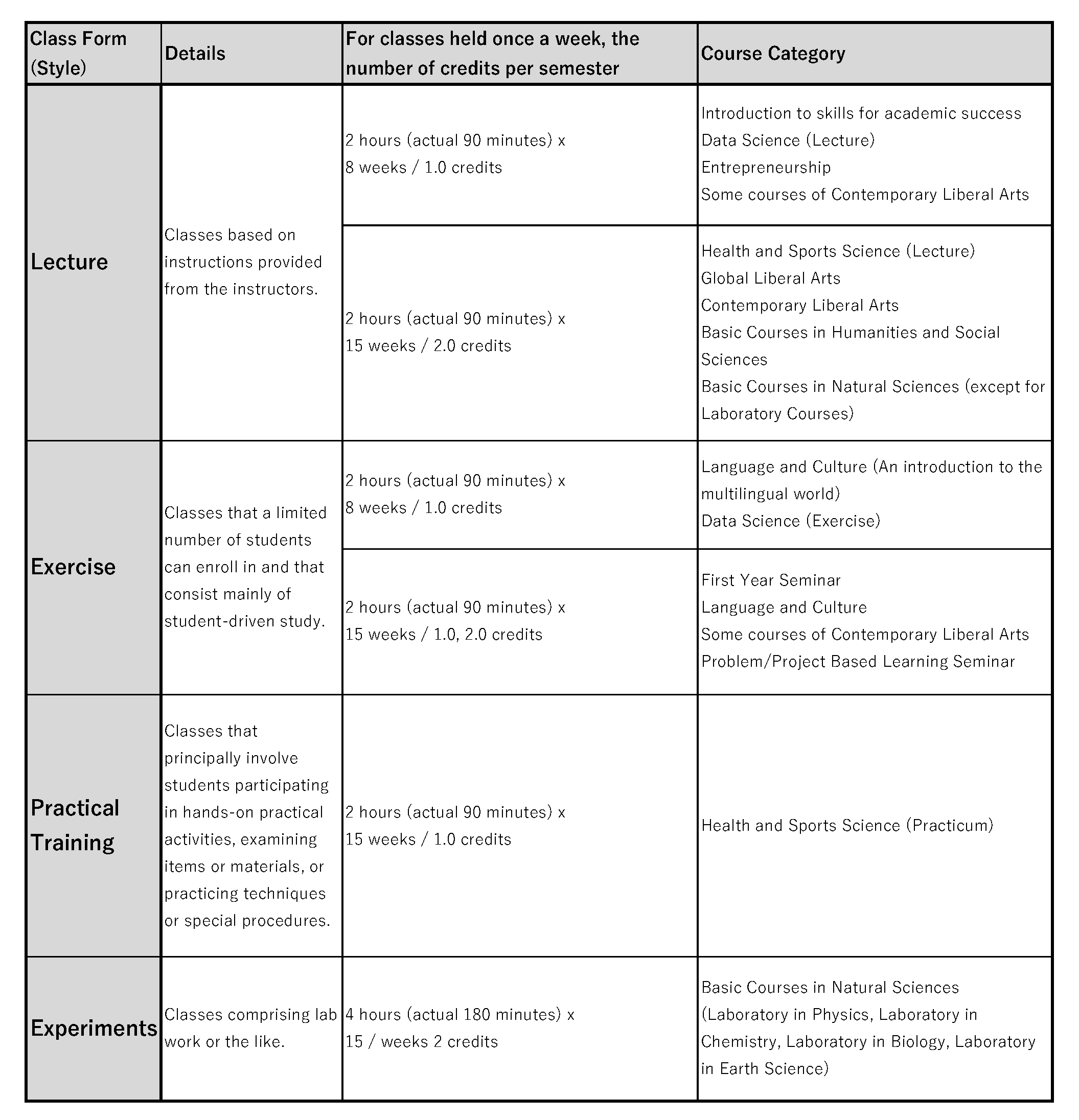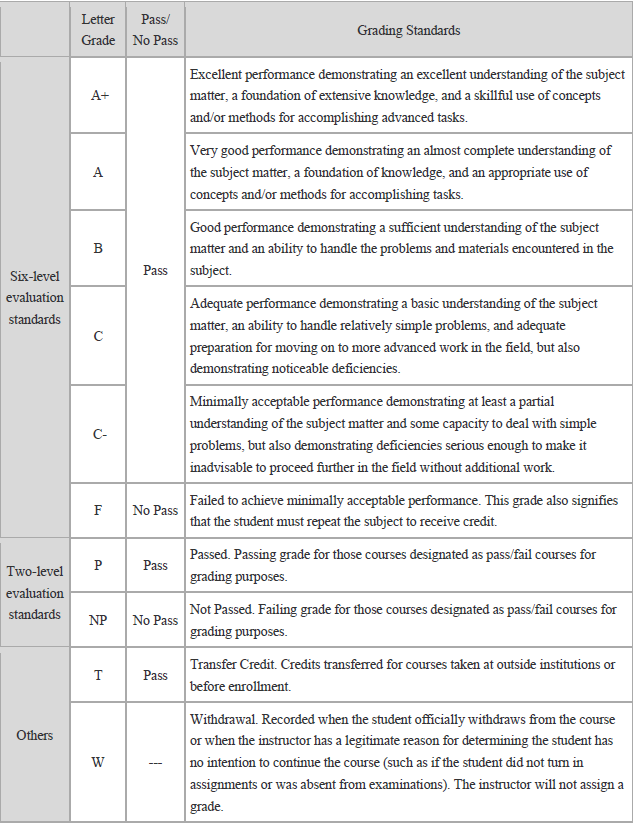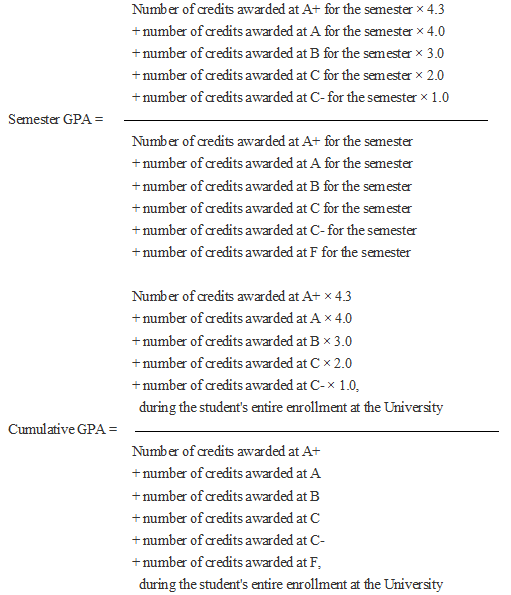How courses are conducted
Academic year and semesters
The academic year begins April 1 and ends March 31 at Nagoya University. The academic year is divided into a Spring semester (April 1–September 30) and a Fall semester (October 1–March 31). In addition, each Semester is divided into two Quarters; Spring Quarter 1 and Spring Quarter 2 (for the Spring Semester), Fall Quarter 1 and Fall Quarter 2 (for the Fall Semester). Each semester comprises 15 weeks of classes, while a Quarter comprises 8 weeks of classes.
| One academic year | |
|---|---|
| Spring semester | Fall semester |
| April 1 – September 30 | October 1 – March 31 |
It should be noted that some courses offered by each school may change its schedule due to circumstances of respective school.
Terms
Because the duration of study is normally four years (six years for the Department of Medicine, School of Medicine), the period of study is eight semesters (twelve for the Department of Medicine, School of Medicine). Starting with the spring semester of the year of enrollment, semesters are numbered in order as follows.
It should be noted that Roman numerals are used to denote terms.
| First year | Second year | Third year | Fourth Year | ||||
|---|---|---|---|---|---|---|---|
| Spring semester | Fall semester | Spring semester | Fall semester | Spring semester | Fall semester | Spring semester | Fall semester |
| Terms Ⅰ | Terms Ⅱ | Terms Ⅲ | Terms Ⅳ | Terms Ⅴ | Terms Ⅵ | Terms Ⅶ | Terms Ⅷ |
Student-free days
Days on which classes are not held are called student-free days. Nagoya University student-free days are as follows. However, classes may be held on those days when necessary for educational reasons.
| Regular student-free days | One-day |
|
|---|---|---|
| Long-term |
|
|
| Special student-free day |
|
|
Class times
At Nagoya University, classes normally continue for two hours (90 minutes of actual instruction). However, classes for some courses such as physics labs, chemistry labs, biology labs, and earth science labs are four hours long (180 minutes of actual instruction).
The time classes begin and end are given below. Classes are labeled as follows starting with the first class of the day. These times are fixed throughout the entire year. They apply to classes at all schools.
Four-hour classes (180 minutes of actual instruction) comprise two normal class times.
| First period | Second period | Third period | Fourth period | Fifth period |
|---|---|---|---|---|
| 8:45 a.m. – 10:15 a.m. | 10:30 a.m. – 12:00 p.m. (noon) | 1:00 p.m. – 2:30 p.m. | 2:45 p.m. – 4:15 p.m. | 4:30 p.m. – 6:00 p.m. |
Class form (style) and the Credit System
Courses are divided into the following types of classes according to the course format.
At Nagoya University a credit system is used to quantitatively indicate the amount of course work a student has completed. To complete a university curriculum program a student must earn a required number of credits in prescribed liberal arts and sciences courses and a required number of credits in courses prescribed by their university school. This is handled in accordance with the standards set by each school.

PDF file is here
※Please check the "course list" for the number of credits earned for each course.
Grade Evaluation (for students enrolled in/after AY2020)
1. Grade Evaluation and Grading Standards
Grade evaluations will be under either a six-level evaluation system (A+, A, B, C, C-, F) or two-level evaluation system (P, NP). F or NP indicate that the course was not passed, and the student will receive no credit for the course.
[Grading Standards and Corresponding Letter Grades]

PDF file is here
2. Recording of Grades in Transcripts
On a transcript, completed courses that have been given a grade using the six-level evaluation system, two-level evaluation system, or given a T grade will be recorded, and courses given an F, NP or W grade will not be recorded. On a course completion confirmation sheet, completed courses and courses from the semester in question where an F, NP or W grade was given will be recorded.
3. Standard method for converting marks-out-of-100 to letter-based evaluation
In some courses, a grade evaluation will be made with a mark out of 100 and converted into a letter grade according to the six-level evaluation standards. The standard method in such case is as follows. However, depending on the undergraduate/graduate school, individual course, etc., this chart may not apply, so please refer to course registration guidelines and course syllabuses for each undergraduate/graduate school and the Institute of Liberal Arts and Sciences.

4. GPA System
As part of our policy to promote the autonomous learning of students and to increase the international compatibility of grade evaluations, Nagoya University has implemented the Grade Point Average (GPA) System, which is the average of grades for registered courses.
(1) Letter Grades and Corresponding Grade Points
Grade Points (numerical values given to each grade letter; hereinafter referred to as "GP") are converted as follows. GP is applicable only to undergraduate students, and not to graduate students. Accordingly, GPAs are only calculated for undergraduate students.

(2) GPA Types and Calculation Methods
There are two types of GPA: the GPA used as an indicator to show the state of learning and performance during the semester in question (hereinafter "Semester GPA"), and the GPA used as an indicator to show the state of learning and performance during the student's entire enrollment at the University (hereinafter "Cumulative GPA"). The formulae for calculating Semester GPA and Cumulative GPA are as follows. Calculated numbers shall be rounded to two decimal places.

PDF file is here
(3) Courses Subject to GPA Calculation
- All courses included in calculations carried out for the purposes of meeting graduation requirements are subject to GPA calculation.
- Courses that are unrelated to graduation requirements, such as optional courses and teacher-training courses, are not subject to GPA calculation.
- Courses receiving an evaluation of P, NP, T or W are not subject to GPA calculation.
- Handling of GPA in the Case of Retaken Courses
- When a student retakes a course for which he or she initially received an F grade and then receives an A+, A, B, C or C- grade, the initial F grade is not be in the calculation for Cumulative GPA.
- When a student retakes a course for which he or she initially received an F grade and then receives another F grade, these F grades shall not be included multiple times in the calculation for Cumulative GPA.
- When a student receives a T grade according to credit recognition based on the results of certification examination for a course for which the student initially received an F grade, the F grade is not included in the calculation for Cumulative GPA.
- When a student has already received credits for a course but then retakes the course and receives an A+, A, B, C, C- or F grade, the retaken course grade is not included in the GPA calculation.
- In the cases described above, the above procedures do not necessarily apply to courses that students are allowed to take multiple times.
(4) GPA Display
GPA is recorded on the end-of-semester course completion confirmation sheet in the form of Semester GPA and Cumulative GPA. Cumulative GPA is indicated on the transcript.
Courses
Please click here (PDF) for information on class subjects.
Please click here (PDF) for the meaning of course numbering codes.
Examinations and grading
It is important to be aware of the following points regarding examinations for Liberal Arts and Sciences Courses.
- Regular examinations are held at the end of the semester.
- As a general rule, tests are written tests, but there are situations when a report, oral exam, experiment report, etc., is used in place of a written test.
- Students must place their student ID on the desk when taking an examination.
- Students are not allowed to enter the examination room if they are more than 20 minutes late.
- Students are permitted to leave the examination room 30 minutes or more after the start of the examination. However, students are not allowed to leave the examination room 5 minutes or less before the end of the examination.
- Students who leave the examination room should do so quietly so as not to disturb other students.
- The examination time is determined by a standard electric clock or the proctor’s watch set to the standard electric clock.
- Students must not cheat during examinations.
- If students are caught cheating, the dean of the school they study at will be notified by the Institute of Liberal Arts and Sciences. Disciplinary measures, such as losing all credits for courses taken that semester, will be decided upon at the school’s faculty meeting based on the “Nagoya University Student Disciplinary Rules.”
Misconducts
Cheating in classes and examinations will not be permitted. Do not cheat on quizzes, reports and final examinations. If misconduct is found, after investigating the fact, the proper measure will be taken in accordance with “Nagoya University Student Discipline Rules”, then the disciplinary action such as expulsion, suspension, or admonition etc. may be taken. In addition, the credits of all the courses in the corresponding semester will be disqualified and you will remain in the same year.
Cheating is likely to occur when a final exam, report due date, or presentation of results is coming up, but students are not prepared for it. The desire to get a good grade or not to lose a credit leads to misconducts such as copying and pasting, cheating, and incomplete citations and references. You should be aware that cheating is neglect of duty as a student, and you are the one who suffers disadvantage.
Please bear in mind the following notes before taking classes /examinations.
- Items not permitted for the examination must not be placed on/in the desk or on the chair, and these items must be put into your bag and the bag must be closed and put on the floor.
- The use of wearable device and plastic sheets for notes (Shitajiki) are prohibited.
- Students must turn off their mobile phones and put them into their bags.
- When you write a report, do not copy and paste from the Internet and so on, and do not infringe anybody’s copyright.
- When you research or conduct an experiment, do not fabricate or manipulate data.
Fabrication: Falsification of data or experimental results
Manipulation:Improper expression of the details of research by adding operation to research samples, devices and/or research processes or by changing or omitting data or research outcomes.
Reference:「良識をもって学問をしよう!(Japanease only)」Center for the Studies of Higher Education, Nagoya University
Handling of classes and examinations with regard to natural disasters
In the event of a typhoon, earthquake, or other natural disaster or when a warning or notification has been announced, all classes and exams of Liberal Arts and Sciences Courses (including regular, make-up, and repeat exams: referred to below according to the directions to be given to students as “classes") will be handled as below.
1. In the Event That a “Storm (Gale) Warning” or Another Special Warning for Nagoya City is Issued by the Japan Meteorological Agency
If a “storm (gale) warning” or another special warning for Nagoya City is announced by the Japan Meteorological Agency, classes, etc. scheduled after the warning is announced are cancelled. However, if the warning is subsequently lifted, classes, etc. will be held as outlined in the table below. Please check the following website of the Japan Meteorological Agency to confirm updates on warnings.
| Time when warning is lifted(following official announcement of return to safe conditions) | Period when classes start |
|---|---|
| Before 6:45 am | 1st Period |
| Between 6:45 am and 11:00 am | 3rd Period |
Important Notes:
- If students are already at university when a storm (gale) warning is announced, return home before the situation worsens.
- If students are on their way to school when a storm (gale) warning is announced, return home.
- As a general rule, ICT-based online classes, etc., will not be canceled. In these cases, please check the statuses of classes on the lecture websites and the TACT (Tokai Academic Combination Tools) LMS (Learning Management System) of the Tokai National Higher Education and Research System.
- Also check the following website of the Japan Meteorological Agency, which is updated frequently.
https://www.jma.go.jp/jma/indexe.html
In the event of an Earthquake or Fire
If an earthquake or other disaster occurs during class, calmly assess the surrounding situation and the scale of the earthquake or disaster, and take all necessary steps to protect yourself. Then, immediately stop the class, follow the instructions of the class instructor, and evacuate to the designated temporary evacuation area, after evacuating, follow the instructions given by the University(ILAS Office).
In the event that Nankai Trough Earthquake Extra Information is released
It has been decided that Nankai Trough Earthquake Extra Information will be released starting on May 31, 2019. The national and local governments have been considering how to respond in case this information is released. You should follow the instructions of the university regarding the conduct of classes, returning home, etc., while also making effort to gather information and ensure your own safety. Furthermore, please note that the response policy may be added or revised hereafter.
In the event of any other disaster or risk of disaster
If it is deemed difficult to hold classes for reasons other than listed above, a decision will be made regarding whether or not to cancel classes.
Rescheduling cancelled classes or examinations, etc.
Announcements of rescheduling of classes canceled due to the above situations will be posted on the Nagoya University Portal etc.
